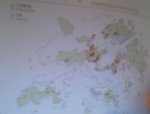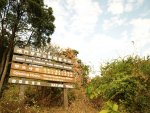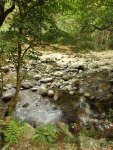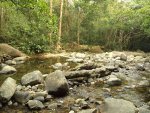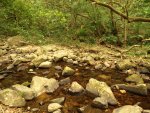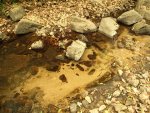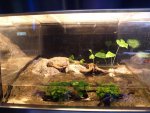A
achiinto
Guest
I have just come back from Hong Kong for an important family event. This is the first time I have come back to Hong Kong since I immigrated to Canada 13 years ago. So, I am not that familiar to the wildlife and nature in Hong Kong, but I have made my attempt to search for Hong Kong Newt during the second week of my trip.
As a summary, I have checked two locations which have a high potential of finding the Newt, unfortunately I couldn’t find any. But in the end, I found the Newt in Hong Kong Wetland Park, which they have about 4 to 5 of them in aquarium. In this case, it doesn’t count.
Although I have not found any Hong Kong Newt, I have made a lot of effort in researching the current status of Hong Kong Newt, purchased some local field guides of Amphibians and also talked to some locals regarding the Newts.
Based on the Local Field Guides prepared by the ‘University of Hong Kong’, ‘Hong Kong Agriculture, Fisheries and Conservation Department’, and ‘Friends of the Country Parks’, I have chosen two locations for my survey: Tai Shing Stream and Tai Po Kau. At first, I thought the newt will breed during spring (based on my knowledge on Canadian amphibians), however, the field guides suggested that the newts breed during the winter from September to March. So, I made the attempt to look for them as soon as I read this information.
Before I start talking about the attempts and showing the habitat photos, let me summarize some information regarding the Hong Kong Newts, which I think are not available on the internet and also might contraries with www.livingunderworld.org.
Hong Kong Newts can be found in the streambed during the breeding season, September to March. Outside of breeding season, the newts spent the time on land. The best time to find them will be during the breeding season. Their habitat is among the clear mountain streams with large rocks and under vegetations. Occasionally, they are found in the catch water. They have been found under leaf litter far away from stream as well, likely after breeding season. Their distribution is widely distributed in unpolluted mountain streams in the New Territories in Hong Kong; more locally distributed in Lantau and Hong Kong Island. Contrary to the www.livingunderworld.org, the field guide stated that Hong Kong newts is not restricted in Hong Kong, but can be found in the coastal region of Guangdong Province. Larvae of the Newt are about 15mm in length and metamorph after 7 months. Cannibalism may occur among larvae. Adult’s length is up to 140mm.
On January 20th, 2009, I went to Tai Shing Stream (marked 1 on the Hong Kong map). This is a stream located near the Shung Mun Reservoir. The best way to access this location is to use the trail of the Shing Mun Country Park. Follow the Shing Mun Country Park Trail to Picnic area 6. At Picnic area 6, you will find a bridge which continues the trail and crosses over the stream. The stream under the bridge is the location that I have observed. The water is very clean and clear. Some leaf litter is rotting in the stream, which is also the one of the primary source of food of the food chain. Although I have not found any newt, this is a stream well known of finding Hong Kong Newts, it is also 1 of the 9 sites highlighted by ‘Hong Kong Field Guides – Hillstreams’, by David Duggeon, as good location for observing hillstream wildlife. Thus, it is a good conclusion to believe that this is a good location to find Hong Kong Newts, especially for first time visitor to Hong Kong, due to the easy access from public transportation. Since January might be kind of late of the newt breeding season, I will suggest checking this site during October and November time instead. Also, since Picnic area 6 is near the end of the Tai Shing Stream, if one may find a good way to go up the stream, there might be a better chance to find the Newt. Unfortunately, I reached the location kind of late in the afternoon, when I reached the site after 45min of walking, it was about time for me to observe nocturnal mammals during my return trip. So, I have only spent around 30mins trying to find the newt, without venturing further up the stream.
On January, 21st, 2009, I went to Tai Po Kau (marked 2 on the Hong Kong map). Tai Po Kau is a Wildlife Reserve in Hong Kong located in a relative rural region. It is a good spot for bird watching of Asian songbirds. It is also a location suggested by the’ Hong Kong Field Guides – Hillstreams’. The Amphibian field guide explicitly mentioned this as a site for observing Newt as well, it is marked by the distribution map of the Newt, provided by the “A Field Guide To The Amphibians Of Hong Kong”. Again, the stream is very clear. I have spotted many fishes swimming in the stream, by sampling one fish, I identified it as Parazacco spilurus. Based on the field guide ‘Hillstream’, the following fishes might share habitat with the Hong Kong Warty Newt, Parazacco spilurus, Nicholsicypris normalis, Puntius semifasciolatus, Oreonectes platycephalus, Pterocryptis anomalus, Ctenogobius duospilus, Pseudogastromyzon myersi, Liniparhomaloptera disparis amd Schistura fasciolata.
There are some books I would suggest anyone who is interested to learn more about Hong Kong Warty Newt, if you are interested in find them, these books will help tremendously.
1) A Field Guide To The Amphibians Of Hong Kong, (2005 June, publisher: Friends of the Country Parks/Cosmos Books limited) (it was previously available for purchase online at Yesasia.com)
2) Hong Kong Field Guide - Hillstreams, (by David Dudgeon, published by University of Hong Kong/ Wan Li Books co. limited, 2003 July) (available for purchase at http://www.yesasia.com/us/search/hillstreams/0-0-0-bpt.48_q.hillstreams-en/list.html)
More photo on other posts.
Attached photos:
1) Very crappy webcam photo of the Hong Kong Newt Distribution Map from the Amphibian Field Guide. (red dots are the exact distribution/ green are Area under protection, White are area without protection
2) Map of Hong Kong.
As a summary, I have checked two locations which have a high potential of finding the Newt, unfortunately I couldn’t find any. But in the end, I found the Newt in Hong Kong Wetland Park, which they have about 4 to 5 of them in aquarium. In this case, it doesn’t count.
Although I have not found any Hong Kong Newt, I have made a lot of effort in researching the current status of Hong Kong Newt, purchased some local field guides of Amphibians and also talked to some locals regarding the Newts.
Based on the Local Field Guides prepared by the ‘University of Hong Kong’, ‘Hong Kong Agriculture, Fisheries and Conservation Department’, and ‘Friends of the Country Parks’, I have chosen two locations for my survey: Tai Shing Stream and Tai Po Kau. At first, I thought the newt will breed during spring (based on my knowledge on Canadian amphibians), however, the field guides suggested that the newts breed during the winter from September to March. So, I made the attempt to look for them as soon as I read this information.
Before I start talking about the attempts and showing the habitat photos, let me summarize some information regarding the Hong Kong Newts, which I think are not available on the internet and also might contraries with www.livingunderworld.org.
Hong Kong Newts can be found in the streambed during the breeding season, September to March. Outside of breeding season, the newts spent the time on land. The best time to find them will be during the breeding season. Their habitat is among the clear mountain streams with large rocks and under vegetations. Occasionally, they are found in the catch water. They have been found under leaf litter far away from stream as well, likely after breeding season. Their distribution is widely distributed in unpolluted mountain streams in the New Territories in Hong Kong; more locally distributed in Lantau and Hong Kong Island. Contrary to the www.livingunderworld.org, the field guide stated that Hong Kong newts is not restricted in Hong Kong, but can be found in the coastal region of Guangdong Province. Larvae of the Newt are about 15mm in length and metamorph after 7 months. Cannibalism may occur among larvae. Adult’s length is up to 140mm.
On January 20th, 2009, I went to Tai Shing Stream (marked 1 on the Hong Kong map). This is a stream located near the Shung Mun Reservoir. The best way to access this location is to use the trail of the Shing Mun Country Park. Follow the Shing Mun Country Park Trail to Picnic area 6. At Picnic area 6, you will find a bridge which continues the trail and crosses over the stream. The stream under the bridge is the location that I have observed. The water is very clean and clear. Some leaf litter is rotting in the stream, which is also the one of the primary source of food of the food chain. Although I have not found any newt, this is a stream well known of finding Hong Kong Newts, it is also 1 of the 9 sites highlighted by ‘Hong Kong Field Guides – Hillstreams’, by David Duggeon, as good location for observing hillstream wildlife. Thus, it is a good conclusion to believe that this is a good location to find Hong Kong Newts, especially for first time visitor to Hong Kong, due to the easy access from public transportation. Since January might be kind of late of the newt breeding season, I will suggest checking this site during October and November time instead. Also, since Picnic area 6 is near the end of the Tai Shing Stream, if one may find a good way to go up the stream, there might be a better chance to find the Newt. Unfortunately, I reached the location kind of late in the afternoon, when I reached the site after 45min of walking, it was about time for me to observe nocturnal mammals during my return trip. So, I have only spent around 30mins trying to find the newt, without venturing further up the stream.
On January, 21st, 2009, I went to Tai Po Kau (marked 2 on the Hong Kong map). Tai Po Kau is a Wildlife Reserve in Hong Kong located in a relative rural region. It is a good spot for bird watching of Asian songbirds. It is also a location suggested by the’ Hong Kong Field Guides – Hillstreams’. The Amphibian field guide explicitly mentioned this as a site for observing Newt as well, it is marked by the distribution map of the Newt, provided by the “A Field Guide To The Amphibians Of Hong Kong”. Again, the stream is very clear. I have spotted many fishes swimming in the stream, by sampling one fish, I identified it as Parazacco spilurus. Based on the field guide ‘Hillstream’, the following fishes might share habitat with the Hong Kong Warty Newt, Parazacco spilurus, Nicholsicypris normalis, Puntius semifasciolatus, Oreonectes platycephalus, Pterocryptis anomalus, Ctenogobius duospilus, Pseudogastromyzon myersi, Liniparhomaloptera disparis amd Schistura fasciolata.
There are some books I would suggest anyone who is interested to learn more about Hong Kong Warty Newt, if you are interested in find them, these books will help tremendously.
1) A Field Guide To The Amphibians Of Hong Kong, (2005 June, publisher: Friends of the Country Parks/Cosmos Books limited) (it was previously available for purchase online at Yesasia.com)
2) Hong Kong Field Guide - Hillstreams, (by David Dudgeon, published by University of Hong Kong/ Wan Li Books co. limited, 2003 July) (available for purchase at http://www.yesasia.com/us/search/hillstreams/0-0-0-bpt.48_q.hillstreams-en/list.html)
More photo on other posts.
Attached photos:
1) Very crappy webcam photo of the Hong Kong Newt Distribution Map from the Amphibian Field Guide. (red dots are the exact distribution/ green are Area under protection, White are area without protection
2) Map of Hong Kong.
Attachments
Last edited:

